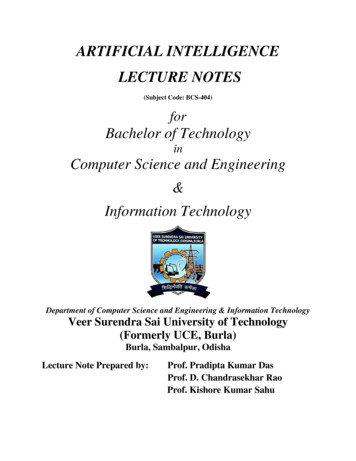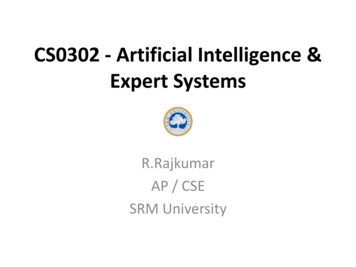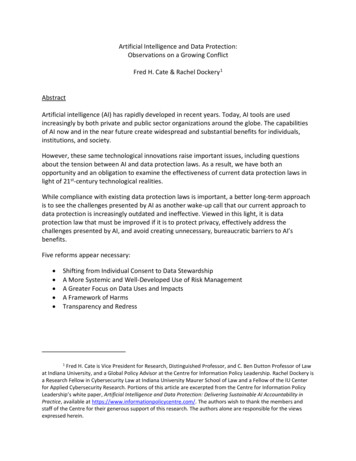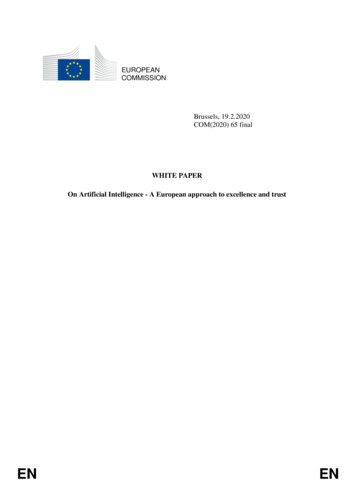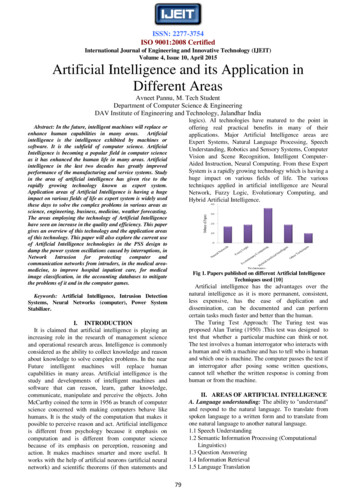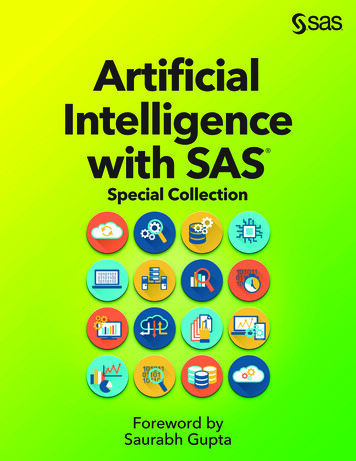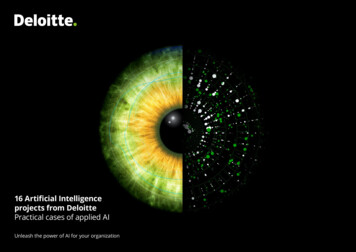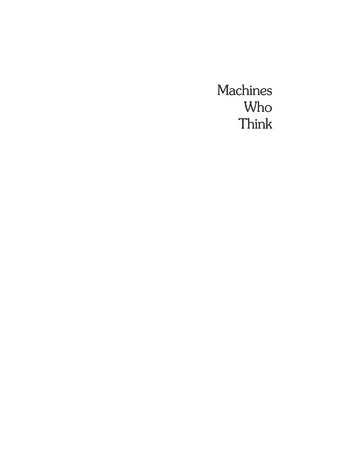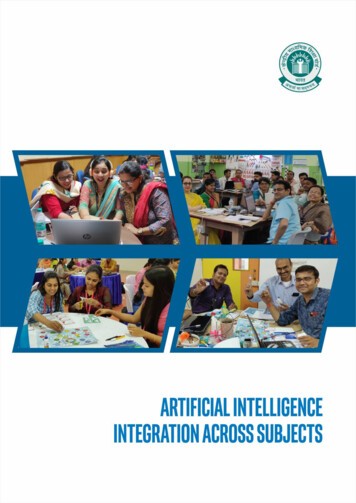
Transcription
ARTIFICIAL INTELLIGENCEINTEGRATION ACROSS SUBJECTSFOR CBSE CURRICULUMCurated with support from Intel
AcknowledgementsPatrons: Sh. Ramesh Pokhriyal ’Nishank’, Minister of Human Resource Development, Government ofIndiaSh. Dhotre Sanjay Shamrao, Minister of State for Human Resource Development,Government of IndiaMs. Rina Ray, IAS, Secretary, Department of School Education and Literacy, Ministry HumanResource Development, Government of IndiaAdvisory, Editorial and Creative Inputs: Ms. Anita Karwal, IAS, Chairperson, Central Board of Secondary EducationMs. Shweta Khurana, Director, Corporate Affairs Intel IndiaGuidance and Support: Sh. Anurag Tripathi, IRPS, Secretary, Central Board of Secondary EducationDr. Joseph Emmanuel, Director (Academics), Central Board of Secondary EducationDr. Biswajit Saha, Director (Skill Education & Training), Central Board of Secondary EducationValue Adder, Curator and Co-Ordinator: Sh. Ravinder Pal Singh, Joint Secretary, Department of Skill Education, Central Board ofSecondary EducationContributors and Content Preparation Team: Ms. Sarita Manuja, Program Director, Nirmal Hriday Education SocietyMs. Sharon E. Kumar, Innovation and Education Consultant, Intel AI4Youth ProgramMs. Ambika Saxena, Coach, Intel AI4Youth ProgramMs. Shyda Rana, Senior Faculty, Army Welfare Education SocietyMs. Shelly Bakshi, Principal, The Olive School, KurukshetraMr. Gunendra K Mishra, Principal, Nutan Vidya Mandir, New DelhiMs. Puneet Sardana, Vice Principal, Salwan Govt. Girls Sr. Sec. School, New DelhiMs. Archana Dixit, PGT Chemistry, Salwan Govt. Girls Sr. Sec. School, New DelhiMs. Sangeeta Sharma, PGT Mathematics /Computer Science, Titiksha Public School, NewDelhi2
About the BookArtificial Intelligence (AI) is a Cognitive Science and the history of its evolution suggests that it hasgrown out of the knowledge derived from disciplines such as Science, Mathematics, Philosophy,Sociology, Computing and others. Hence, it is fair for any education system to recognize theimportance of integrating AI Readiness to maximize learning across other disciplines.AI is being widely recognized to be the power that will fuel the future global digital economy; and hasgained geo-strategic importance. A large number of countries are striving hard to stay ahead withtheir policy initiatives to get their youth ready to function in an environment driven by AI and otheremerging technologies.India’s own AI Strategy identifies AI as an opportunity and solution provider for inclusive economicgrowth and social development. The report also identifies the importance of skills-based education (as opposed to knowledge intensive education), and the value of project related work in order to“effectively harness the potential of AI in a sustainable manner” and to make India’s next generation‘AI ready’.CBSE has introduced Artificial Intelligence as an optional subject at Class 9 from the Session 20192020 onwards and has been conducting trainings for Teachers on how to use AI in the Classroom. ATraining Video has also been prepared to assist the same.CBSE is now announcing AI as a multi-disciplinary integrated pedagogical approach to furtherenhance teaching and learning across classes 6 to 12. This document is an attempt to propose howschools may train the trainers to match relevant topics/ themes from the curricula with AI concepts.It contains details on the importance of Artificial Intelligence and Artificial Intelligence Tools as apedagogical support for experiential learning. Guidelines for Teachers can be found in the form ofLesson Plans integrating AI in Classroom Teaching.How this Integration Document was created:In keeping with the vision of CBSE to introduce and train Teachers on AI readiness, and the usage ofAI in classroom teaching and learning practices; a discussion was initiated with AI experts andTeachers of various Subjects from CBSE Schools.3
Lesson Plans in each Subject were discussed and written, and a suggestive list of activities andprojects integrating Artificial Intelligence into regular subject teaching was curated and compiled forreference, as an AI Glossary, which accompanied each Lesson Plan to facilitate ease of reference andusage.Identifiedcompetent CBSESchool Teacherswith background indifferent Subjects,AI, Integration,TrainingCreated a WorkingGroup andOriented then onthe AI ReadinessCurriculum andIntegration ProcessOrganized anExhaustive ThreeDay Workshop toBrainstorm andIdentify Chaptersfor Integrationfrom each SubjectDevelopedExemplars acrossSubjects andMapped them withvarious ArtificialIntelligence Toolsand ApplicationsValidated eachExemplar andadded a Glossaryfor ReadyReference and Easeof UseFigure 1: How this Integration Document was createdIt is important to understand that AI is one of the cognitive science disciplines that provides tools tobuild intelligence in contrast to other disciplines that just study and analyze the external behavior ofintelligent agents. Realizing this need, it has been decided that all teachers teaching in CBSE schoolsshould familiarize themselves with the prevalent AI knowledge and use it to make learning of theirsubjects more effective and student centered. It is visualized that such a step would help to buildlarger understanding of AI among teacher and student communities.It is highly recommended that teachers explore the Exemplar Lesson Plans and Glossary in thisdocument, and go beyond what has been showcased, to develop more such exemplars and teachingmethodologies integrating Artificial Intelligence in day to day learning across subjects, for students.4
ContentsChapter 1: An Introduction to Artificial Intelligence1.1An Introduction to Artificial Intelligence71.1.1 History of Artificial Intelligence81.2AI in Education91.3CBSE’s initiative on Artificial Intelligence101.4Twin Initiative on AI101.5AI Integrated Education111.6An AI Integrated Class161.7AI can help Teachers to Achieve the Desired Learning Outcomes171.8Effective Pedagogy Incorporating AI in the Class Room181.9Role of Schools in the Success of CBSE Directive for AI Integrated Learning181.10Meeting National Goals of NCF/ NCERT/ NA through AI Integration201.11AI Optimism22Chapter 2: How to Integrate AI in School Teaching– A Call to Teachers2.1AI Is not alone232.2Principles of AI integrated learning232.3Objectives of AI integrated learning242.4Practice AI X Paradigm for Integration242.5A Sample AI Integrated Lesson Plan explained252.6Assessment at the end of AI integrated Learning29Chapter 3: AI Integrated Activities – Exemplars3.1 ENGLISH3.1.13.1.23.1.33.1.43.1.5Class 6Class 7Class 8Class 9Class 103134394248Class 6513.2 HINDI3.2.15
3.2.23.2.33.2.43.2.5Class 7Class 8Class 9Class 10545760643.3 SCIENCE3.3.13.3.23.3.33.3.43.3.5Class 6Class 7Class 8Class 9Class 1068727679823.4 MATHEMATICS3.4.13.4.23.4.33.4.43.4.5Class 6Class 7Class 8Class 9Class 1086899296993.5 SOCIAL SCIENCE3.5.13.5.23.5.33.5.43.5.5Class 6Class 7Class 8Class 9Class 10104110113116121Chapter 4 Appendices4.1Appendix 1 – Artificial Intelligence Curriculum, Class 91274.2Appendix 2 – AI Learning Indicators1364.3Appendix 3 – AI Learning Outcomes1374.4Appendix 4 – AI Capabilities1384.5Appendix 5 – AI versus Internet of Things (IOT); AI versus Virtual Reality (VR)1394.6Appendix 6 – Translating AI on Ground1406
Chapter 1AN INTRODUCTION TO ARTIFICIAL INTELLIGENCE1.1 What is Artificial Intelligence?Artificial Intelligence has always been a term which intrigues people all over the world. ArtificialIntelligence (AI) refers to the ability of machines to perform cognitive tasks like thinking, perceiving,learning, problem solving and decision making; it is inspired by the ways people use their brains toperceive, learn, reason out and decide the action.Various organizations have coined their own versions of defining Artificial Intelligence. Some of themare mentioned below:NITI Aayog: National Strategy for Artificial IntelligenceAI refers to the ability of machines to perform cognitive tasks like thinking, perceiving, learning,problem solving and decision making. Initially conceived as a technology that could mimic humanintelligence, AI has evolved in ways that far exceed its original conception. With incredible advancesmade in data collection, processing and computation power, intelligent systems can now be deployedto take over a variety of tasks, enable connectivity and enhance productivity.World Economic ForumArtificial intelligence (AI) is the software engine that drives the Fourth Industrial Revolution. Itsimpact can already be seen in homes, businesses and political processes. In its embodied form ofrobots, it will soon be driving cars, stocking warehouses and caring for the young and elderly. It holdsthe promise of solving some of the most pressing issues facing society, but also presents challengessuch as inscrutable “black box” algorithms, unethical use of data and potential job displacement. Asrapid advances in machine learning (ML) increase the scope and scale of AI’s deployment across allaspects of daily life, and as the technology itself can learn and change on its own, multi-stakeholdercollaboration is required to optimize accountability, transparency, privacy and impartiality to createtrust.European Artificial Intelligence (AI) leadership, the path for an integrated vision AI is not a welldefined technology and no universally agreed definition exists. It is rather a cover term for techniquesassociated with data analysis and pattern recognition. AI is not a new technology, having existedsince the 1950s. While some markets, sectors and individual businesses are more advanced thanothers, AI is still at a relatively early stage of development, so that the range of potential applications,and the quality of most existing applications, have ample margins left for further development andimprovement.7
Encyclopedia BritannicaArtificial intelligence (AI), is the ability of a digital computer or computer-controlled robot to performtasks commonly associated with intelligent beings. The term is frequently applied to the project ofdeveloping systems endowed with the intellectual processes characteristic of humans, such as theability to reason, discover meaning, generalize or learn, from past experience.In other words, AI can be defined as:AI is a form of intelligence; a type of technology and a field of study. AI theory and developmentof computer systems (both machines and software) are able to perform tasks that normally requirehuman intelligence. Artificial Intelligence covers a broad range of domains and applications and isexpected to impact every field in the future. Overall, its core idea is building machines andalgorithms which are capable of performing computational tasks that would otherwise requirehuman like brain functions.1.1.1 History of AI – Live ScienceThe beginnings of modern AI can be traced to classical philosophers' attempts to describe humanthinking as a symbolic system. (see Annexure 4.5) But the field of AI wasn't formally founded until1956, at a conference at Dartmouth College, in Hanover, New Hampshire, where the term "ArtificialIntelligence" was coined. The graphic below appropriately explains why AI is a live science, what arethe ups and downs in the pace of AI journey and how AI progressed in this domain from the 17/history-artificial-intelligence/8
1.2 What do we understand by AI in EDUCATION?An effective education system has the dual responsibility to develop the most critical resource (i ethe human resource) of a nation. One, that the younger generations must be educated in a way thatthey are ‘ready for life’ and are positive contributors to the advancement & enrichment of theirnation. Second, they must be exposed to such learning environments with the help of updated toolsand enlightened teachers so that their learning outcomes could be maximized and suited to thepotential of every learner. In order that modern-day education achieves its goals of making itsstudents ‘AI Ready’, it is imperative to know what K-12 learners must experience and confront in theirday to day life.AI is underlying the multitudes of its applications in the world; it encompasses and works on an arrayof capabilities which have universal application in different areas of study and operations. Some ofthe most important AI competencies with significant commonalities and connections with those ofthe other fields of study are shown in the graphic al-intelligence/A careful study of the above graph would lead us to believe that many of the technologies and theunderlying principles that each of these follows, have a strong correlation with the teaching learningprocesses at school as well as college levels. Hence it is necessary that AI should not only beintroduced as a subject in the school curricula, but also should become a link to teach other subjectsat all the levels. Many of the AI based applications are now available to facilitate a learner to learn inhis own unique way and at his own pace.9
1.3 What is CBSE’s new initiative encompassing Artificial Education?Making school students ‘AI Aware’ or forging ‘AI Readiness’ among students is a huge task indeed.Central Board of Secondary Education under the guidance of Ministry of Human ResourceDevelopment has taken a ‘twin initiative’ in this regard.First is to introduce AI as an elective subject in classes 8,9 and 10. To begin with, schools have toapply to CBSE and be approved to run this course. AI curriculum for classes 8 and 9 has been chalkedout and a Facilitators’ Handbook has been produced. CBSE is also supporting extensive teachertraining for the teaching of AI in schools.The Second part of CBSE initiative deals with the premise that AI is a Cognitive Science which can belinked to various subjects that concern themselves with cognition and reasoning. Almost every oneof the school subjects would fall in this domain. Be it - Mathematics, Computing, Neuro-Sciences,Psychology, Physics, Economics, Sociology, Philosophy, Languages and some others. It is, therefore,mandated by CBSE that all its schools would begin to integrate AI with other disciplines from classes1 -12.1.4 What is the rationale for this Twin Initiative? Initiative 1: Artificial Intelligence permeates thelength and breadth of the world we live in today. Our young generation is witnessing many uses ofAI every day. While Google manages our mail accounts, it also makes suggestions about what wordsto use to respond to a given email and/ or project follow up reminders. Facebook not only connectsus with friends but also makes suggestions about our priorities, personal needs and preferences.Today we witness smart parking spaces as well as have cars that park themselves. In many advancedcountries the traffic is monitored, controlled and managed by using the data collected of movingtraffic and prevalent weather conditions. Chat bots collect data for big and small businesses to assessthe market requirements of their products and also support the respective business houses ininteraction with the customer and resultant satisfaction. There are also AI powered devices tosupport households in simple tasks such as cleaning etc. All the domains of life - from medicine tomanufacturing to national security and defense – are currently getting impacted by the use ofArtificial Intelligence. Space missions, which extensively use unmanned space shuttles and unmannedvehicles to traverse the unknown areas of other planets, collect tremendous data not only tounderstand the planet they go to but also to acquire intelligence about the betterment of their ownoperations in future. Hence, it is essential that students of today should study this domain tounderstand and later be able to expand this knowledge in their own interest and in the interest ofhumanity.Initiative 2: It is important to understand that AI is one amongst the cognitive science disciplines thatprovides tools to build intelligence in contrast to other disciplines that just study and analyze theexternal behavior of intelligent agents. Realizing this need, it has been decided that all teachersteaching in CBSE schools should familiarize themselves with the prevalent AI knowledge and use it tomake learning of their subjects more effective and student centered. It is visualized that such a stepwould help to build larger understanding of AI amongst the teacher and student communities.10
This document is an attempt to suggest how schools may train the teachers of class 6 –12to relate to the relevant topics/ themes from their respective curricula with technologiesthat AI deploys. The document will also showcase to the teachers the AI based tools thatcan support and augment learning across disciplines, in and out of the classrooms. Theextensive AI glossary and the App Matrix is an effort to include a list of varied resources forteachers to extend the integration activity to other topics of their respective subjects.1.4 What do we mean by AI Integrated Education?AI integration with the other school disciplines is to be viewed from two different perspectives.Perspective 1: While exploring the possibilities to integrate subjects with AI, it was felt that it can bea two-way process. The teacher may select a topic from the subject that easily lends itself to any oneof the AI concepts. He/she would, then, either select the AI concept as a tool to teach the subjecttopic chosen by him/her or using the understanding of the topic, he/she may be able to show alinkage to AI knowledge and usage.For example: ‘Data Collection’ is a familiar task in Mathematics and ‘Data Acquisition’ is an importantbasic AI concept. The teacher may use an AI based app to demonstrate Data collection in aMathematics Class or teach the concept and functionality of the AI application through theirunderstanding of the Data Collection operations in Mathematics.Perspective 2: A practicing teacher may consider one subject AI integration with it, which is a simplerand more functional approach. Example 1 is one such sample given below, in which a Physics topic isintegrated with AI concepts.The other approach could be to have inter disciplinary integration, in which the teacher may pick upone such topic from her own subject that has relevance to other subjects also. Then, in consultationwith other teachers, the four of them could explore the same topic to achieve the learning outcomesof their respective subjects, while at the same time integrating each subject with AI. (see example 2below)The former approach is feasible in normal classroom teaching, the later would have to take the shapeof a project and would have to be conducted in large class groups over a span of time.11
Example 1:Science – Class 9 Integration with AIPHYSICS CLASS: 9PARAMETERSDESCRIPTIONChapter CoveredName of the bookSubject & ArtificialIntelligenceIntegratedLearning ObjectivesChapter 12 - Sound (Frequency, Amplitude & Velocity)NCERT Science Text Book for Class 9Frequency, Amplitude & Velocity integrated with theinfinite Drum Machine experimentTime RequiredClassroomArrangementMaterial RequiredAI CONCEPTSINTEGRATEDTo understand and apply the principles of sound- wavelength- oscillation- amplitude- pitch- frequency of sound- concept of velocity (speed) of sound- concept of ‘intensity’ of sound & be able to differentiateit from ‘loudness’ to appreciate the role of medium ofsound in the above phenomenon to experience the AIconcept of ‘unsupervised learning’Two periods of 40 min each.Normal Classroomlaptop/ desktop or smart mobile phone with internetconnection, chalk, blackboardPre- Preparation Materials for sound experiments as given in NCERT textActivitybookPreviousStudents know the concept of how sound is produced andKnowledgepropagated through a mediumMethodology Lead the students to an understanding and Sound operatedapplication of the following principles of sound by devicesrelating it with demonstration of different soundsand wave diagrams- wavelength (pg. 164)- oscillation (pg. 164)Infinite Drum machine- frequency of sound (pg. 164)- pitch (pg.165)- amplitude (pg. 165)12
LearningOutcomesFollow-up ActivityReflections Explain the concept of velocity (speed) of sound & therole of medium of sound by diagrams and through formulas Make them understand the concept of ‘intensity’ ofsound & be able to differentiate it from ‘loudness’ (pg. 166) Help them to differentiate between amplitude andfrequency which otherwise seem to be very similarcharacteristics of sound Direct the students to The Infinite Drum Machineactivity Link how different sound sensors work in one andmultiple directions by giving examples of different soundoperated devices eg. a door being opened and closed inmovies and an instrument turning on and off by clapping.Students will be able to Differentiate between amplitude and frequencies ofsound waves. Relate performances of different musical instrumentswith amplitude and frequencies understand and relate how sound is applied in AI basedsolutions demonstrate that the unsupervised machine finds itsown ways to make a representation of the data.Hold a brief class discussion on the following topic andobserve what the students say and which concepts are stillnot clear to them.Ask them to award a score to themselves based on howmuch they could contribute to the discussion“Guess which sound has a higher pitch and why - a car hornor flute.”Discuss the AI basis of Infinite Drum Machine.13
GLOSSARY:1. AI Related TerminologiesInfinite Drum Machine: An infinite drum machine is an AI experiment developed by Google for peopleto understand how unsupervised-learning works. In this machine, thousands of sounds found in oursurroundings have been randomly fed for the machine to make sense out of them. The sounds arenot labelled in any way nor does the machine have any other information about that sound. All thatit knows is the sound clip itself. Using one of the unsupervised learning algorithms, the machineanalyses the data fed to it and tries to cluster similar sounds together. These clusters are then visiblewith the help of colors on the user’s screen. All the dots appearing on the screen are sound clips andthey have been clustered together on their basis of their sound properties like amplitude, frequencyand pitch with the help of which the machine is able to understand the similarity amongst differentclips.Link to Infinite Drum Machine: /view/Video to know more: https://youtu.be/9x- My5yjQY2. AI Activity Description:Ask the students to go to the link: /view/ andclick on start playing.Ask the students to do the following:Move the circles appearing on the map all over. When they move the circles, they will hear varioussounds. Ask them to notice the difference in their frequencies, amplitude and pitch.Now, move a circle in just one area, where the dots are of the same color. Ask them to observe if thesounds are similar. They will notice that the sounds from the same color dots have similar properties.With the help of this experiment, explain the unsupervised learning concept to the students wherethe machine is interpreting sounds on the basis of various parameters like amplitude, frequencyand/or pitch.On the basis of this analysis, demonstrate that the machine is able to group similar sounds and is ableto cluster them together in the same color.Mention to the students that random sounds were recorded from the surroundings and were fed tothe unsupervised machine learning model. The machine itself, identified the pattern out of them andclustered them in different groups.Ask students to create their own beats by selecting any 4 sounds and pressing the play button shownat the bottom left corner. They can also select a filter which will highlight all those sounds whichcome under it.14
Example 2:Interdisciplinary Integration with Artificial Intelligence - Class 9AI Integration usingGoogle Story SpeakerAI Integration usingComputer VisionEnglishWrite a newspaper article suggesting strategies toimprove the food production in the country.A discussion - "With the population rise in Indiamore farmland areas is needed, while India isalready intensively cultivated "Do you thinkAritificial Intelligence is the way to solve thisproblem?"ScienceHigher yields of foodWhat do we do to get higher yields in our farms?Case study - Why can we not make do with thecurrent levels of agriculture production?Theme Class 9ScienceChapter 15Improvement in Food ResourcesGeographyMathematicsDoes climate inpact grain production? How canyou suggest ways to predict the climate andprotect crops? What are the ideas you suggest forimproving the natural irrigation system?Problem Solving - Considering the population ofIndia is more than 1 billion people and we need aquarter of a billion tonnes every year, what datawill you collect to present your research report?AI Integration using NaturalLanguage ProcessingAI Integration usingData Exploration15
Since, Artificial Intelligence is a Cognitive Science and the history of its evolution suggests,it has grown out of the knowledge systems derived from other disciplines like Science,Mathematics, Philosophy, Sociology, Computing and others, it is fair for students to see thelinkages. Hence, it is fair for any education system to recognize the importance of itsintegration with the teaching of other disciplines, to maximize learning.1.6 What would the students do in an AI integrated Class?A working group at CBSE has put together 7 Big Markers that may be adopted to develop a structuredaction plan by the teacher for K-12 learners.#Marker 1. Identifying the problem is the starting point of the learning cycle; students of all levelswithout any exception must be exposed to the skill of scoping and identifying the problem. Havingdone so, the learners of all ages must learn the way to state the problem to their parents/ teachers/themselves/ community/ team, they are working with or working for.# Marker 2. Data acquisition related to the identified problem is another big domain for learning andit is a logical next step to proceed with. Such an exercise will prepare the students to attempt thenuances of problem solving which is also an important aspect of the AI project cycle.# Marker 3. Computers are machines which can also ‘see’, ‘hear’ and ‘speak’. So, as such, they can beused to collect data for us. Many applications are now available which make our machines very usefulfor this purpose. An exposure to such capabilities of the machine needs to be explained to studentsof all grades. By using AI in teaching, the expectation is that the teacher will lead students to identifythese tools and consequently use them to improve the learning process.# Marker 4. Learners must learn to represent the collected data in the form of identifiable models.Once the students have the data to solve the problem, they can progressively be made to developthe skill of representing the collected data in visual presentations in the form of graphs, charts etc.The understanding and skill to build such comprehensible models is critical learning for a 21st centurystudent. Computers are the given machines which help store data and represent models.# Marker 5. Computers also learn by themselves from the newer data acquired by them to build newerand better models in the future. With interaction of inputs from the training data available to themachines, just like the human mind, the machines are able to produce entirely different models/representations. Students of all grades need to be made aware of such capabilities which makemachines “intelligent”.# Marker 6. For training the machine, it needs to interact with humans (intelligent agents); Thoughsuch interactions make the machine more and more intelligent, it can never be presumed that themachine would ever be as intelligent as humans are. It is highly impossible for the machine to reachthe capabilities of the human mind. The Robots (as these machines are sometimes called), would attheir best be able to improve the efficiency of human beings and never really be able to replicate it.Such debates need to be part of discussions in the class when AI is integrated with other subjects.16
# Marker 7. AI applications can be beneficial or harmful in the long run. What, when, where and towhat extent should these AI applications be built? At what stage and in what ways can an AI basedapplication be used or not used? Students of all age groups in class 1-12 should be sensitized to AIethics through different simulations, role plays, discussions and debates.1.7 How can AI integrated teaching help teachers to achieve the desired learning outcomes?While the debate regarding how much screen time is appropriate for children rages on amongeducators, psychologists, and parents, Artificial Intelligence and Machine Learning are additionalemerging technologies that are beginning to alter education institutions and changing how educationmay happen in the future. Even though most experts believe the critical presence of teachers isirreplaceable, there have to be many changes to the way a teacher’s job is done and to educationalbest practices.As AI educational solutions continue to mature, the hope is that AI will help fill need gaps in learningand teaching and allow schools and teachers to do more than ever before. AI can drive efficiency,personalization and allow teachers some extra time to deploy their understanding and adaptability—uniquely human capabilities, to teach, where machines would struggle. By leveraging the bestattributes of AI machines and teachers, the education system will be driven towards the bestoutcome for students. Since the students of today will need to work in a future where AI is no longera notion but is the reali
About the Book . Artificial Intelligence (AI) is a Cognitive Science and the history of its evolution suggests that it has grown out of the knowledge derived from disciplines such as Science, Mathematics, Philosophy, Sociology, Computing and others. He

